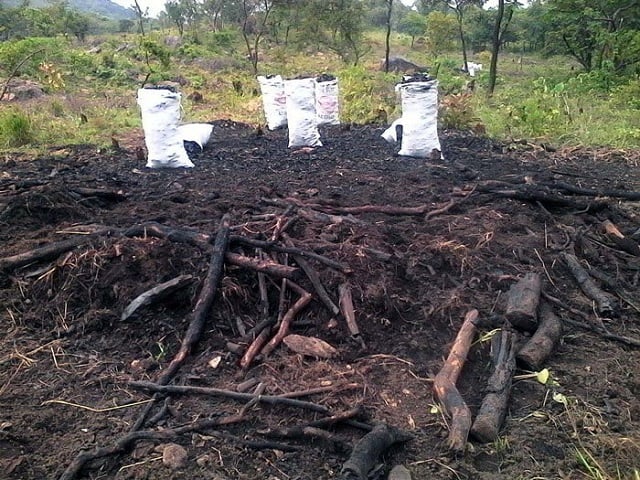Brick burning threatens indigenous trees in Bukedea

The recent studies conducted by Africa Natural Resources Institute indicate that forest cover loss has now increased to an estimated 200,000 hectares annually. PHOTO | FILE
What you need to know:
- Forest cover. The recent studies conducted by Africa Natural Resources Institute indicate that forest cover loss has now increased to an estimated 200,000 hectares annually.
- The situation is being blamed partly on Uganda’s booming population, which is growing at a rate of about 3.6 per cent per annum leading to exerted high pressure on the forest resources in order to derive people’s livelihoods.
Leaders in Bukedea District have warned that the indigenous fruit trees could face extinction if locals continue cutting down trees for brick making.
Brickmaking is a major source of income for the unemployed youth in the district, especially during dry season.
The most endangered tree species are mango trees (Mangifera Indica).
“During the 1994 famine, which badly hit Teso Sub-region, people largely ate mangoes for survival. I wonder why many have quickly forgotten about that in Bukedea,” Mr Denis Ononge, a resident, said.
Mr Ononge added that most pregnant women and children still rely on mangoes as a source of vitamins.
Some students and teachers from Bukedea Secondary School, Kasoka Primary School and St Theresa Okunguro Secondary School also trek to eat mangoes at midday before the afternoon classes.
“My mother barely gave me money for lunch while I was at high school but mangoes catered for that,” Mr James Ekoroi, who studied in Bukedea Secondary School between 2001 and 2004, told Daily Monitor in a recent interview.
But in the past eight years, the situation has changed as many trees have been cut down.
The mango forest, which covered nearly four square kilometres was planted by Elias Emokori, one of the first colonial chiefs in Teso.
Mr Mike Okwi, the district councillor for Bukedea Sub-county, blames the destruction on the growing population.
“A number of new families, many-descendants of Elias Emokori have cleared the forest for settlement. However, many of the mango trees are also sold to brick burners,” Mr Okwi said, adding that the growing demand for bricks is also to blame.
Brick makers say
Mr Simon Omonuk, a brickmaker from Kachede Village in Kabarwa Sub-county, said they prefer mango logs because they are cheap, long, and burn faster than other species.
“You can even use them when still ‘wet’ [fresh after cutting down],” Mr Omonuk said.
He said a fully grown mango tree can be bought at Shs80,000 and can burn more than 15,000 bricks.
“If you have fewer bricks, you can buy off some branches from the tree,” Mr Omonuk, who has burnt bricks for more than 10 years, said.
The law
Mr Jackson Ojekede, the Kamutur Sub-county chairperson, said lack of knowledge on climate change has fostered the cutting down of trees.
Mr Ojekede tasked the district authorities to tighten the law.
According to Section 4(3) of the National Environment Act 2019, government shall apply precaution and restriction measures in all activities that can lead to the extinction of species, the destruction of the ecosystems or the permanent alteration of the natural cycles.
Section 23 (2) provides that urban and district councils may, in consultation with the Authority, make ordinances and bylaws to regulate various aspects of the environment and natural resources within their jurisdiction.
Mr David Oluka, the Bukedea District natural resources officer, said law enforcement is, however, affected by lack of resources and manpower.
“Much as there are ordinances and bylaws set up by the district and sub-county councils to protect the environment, the enforcement is not being done and this is evident because no one has been arrested and prosecuted in the last three years,” Mr Oluka said.
He added that because of poverty, people continue to cut trees for charcoal and bricks making.
“...the central government should instead employ affirmative action if the next generation is to have a friendly interaction with the ecosystem,” Mr Oluka said.
Local interventions
However, Soroti Catholic Diocese under its community development organisation SOCADIDO in 2019 launched a Shs5.3b three-year project aimed at restoring the wetland and forest cover in Bukedea and Kumi districts.
The project dubbed Echo-Restore targets distribution of indigenous trees to more than10,000 households and is hinged on four pillars including tree planting, disaster risk reduction in flood and drought-prone areas, regeneration of swamps and establishment of village savings groups.
It is currently being implemented in the sub-counties of Kolir, Kabarwa, Kamutur, Aminit, and Kangole in Bukedea District while in Kumi District, the sub-counties of Kanapa, Ongino and Kumi are enrolled.
Ms Florence Agoe, the project officer Echo-Restore, said they received the funding from the German ministry of foreign cooperation for development and it aims to restore the five valley dams in the two districts as this will create water reservoirs.
“This disaster risk reduction component also includes restoring and regenerating 40 wetlands along the River Sironko and Lake Bisina belt,” Ms Agoe said.
She added that 3,000 village savings groups are to be established in order to boost household income.
Leaders of Kumi and Bukedea lauded Soroti Catholic Church for their fight against climate change. “Credit needs to be given to SOCADIDO but Bukedea needed to have started this 10 years ago because floods and drought have already taken a toll as food insecurity is already being felt in communities as a result,” Bukedea District chairperson Moses Olemukan said.



